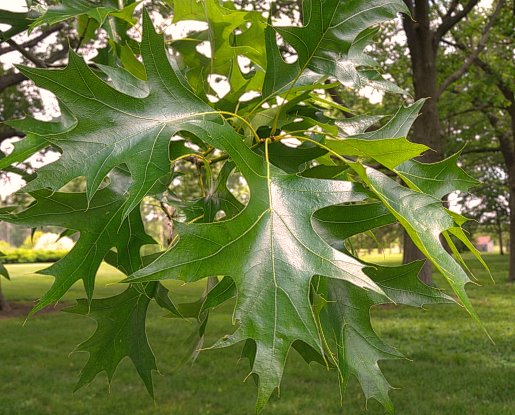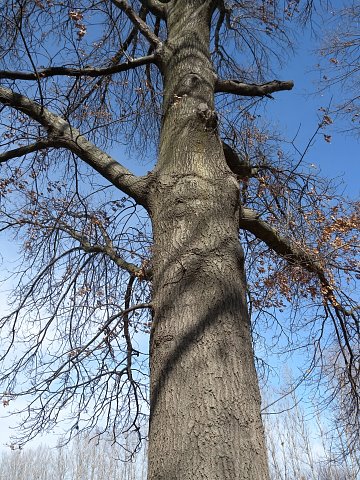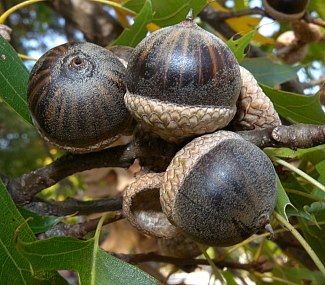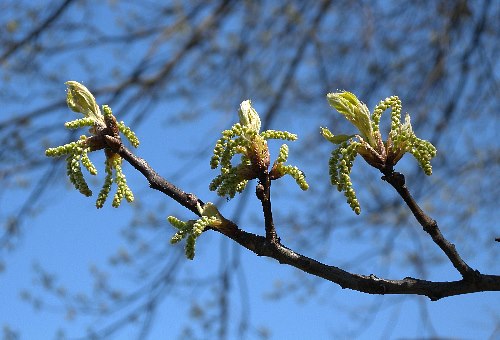
Alternate deciduous leaves occur along twigs and young shoots; because they are often bunched together, the leaves may appear opposite or whorled. Leaf blades are 2½-6" long and deeply pinnatifid with 5-7 bristle-tipped lobes. The lobes taper to narrow points and they are separated by wide concave sinuses. The upper blade surface is medium to dark green, hairless, and shiny, while the lower blade surface is pale green and largely hairless, except for tufts of hair at the junctions of major veins. The slender petioles are light green or yellowish green, hairless, and shiny; they are ¾-2½" long. Pin Oak is monoecious, producing separate male (staminate) and female (pistillate) flowers on the same tree when the leaves emerge during the spring. Male flowers are produced on twigs of the preceding year in the form of drooping catkins; they are yellowish green and about 1½-4" long. Female flowers are produced on leafy shoots of the current year in the form of short spikes less than ¾" long; there are 1-4 female flowers per spike. Each male flower has several stamens, while each female flower has an ovary with 3 stigmata.

The blooming period occurs during mid- to late spring for about 1-2 weeks; flowers are cross-pollinated by the wind. Fertile female flowers are replaced by acorns that take two years to develop; they mature during autumn of the second year. Mature acorns are about 1/3-1/2" (8-12 mm.) long and similarly across; each acorn is globoid or subgloboid in shape with a shallow cap that extends downward to about one-fourth the length of the acorn. The small scales of the cap are overlapping and appressed. The body of a mature acorn is medium brown to nearly black, often with narrow vertical lines along its sides; the apex of the body underneath the cap is tan. The cap of a mature acorn is light brown to reddish brown and either glabrous or sparsely canescent. The woody root system has numerous lateral roots that are shallow and spreading. The leaves of Pin Oak become yellow, red, or brown during the autumn; they sometimes persist on the branches of this tree during the winter.
Cultivation: The preference is full sun, moist well-drained conditions, and a somewhat acidic soil that contains sand, clay, or loam. Flooded conditions are tolerated during winter and early spring dormancy, but not during the period of active growth. Partial sun is also tolerated, but it may cause die-back of some branches. Because it lacks a deep taproot, Pin Oak transplants more easily than most oaks. It also grows faster than most oaks. Longevity of a healthy tree is typically 100-150 years. Pin Oak is vulnerable to oak wilt disease, which can be fatal.
Range & Habitat: Pin Oak is occasional to locally common in the southern half of Illinois, becoming less common or absent in parts of northern Illinois. Habitats consist of floodplain woodlands, flatwoods in upland areas, poorly drained areas of sandy woodlands, gravelly acidic seeps in wooded areas, and higher ground in swamps. These habitats often have a layer of clay subsoil that inhibits drainage; Pin Oak also occurs in habitats with moist sandy soil. Because of the relatively thin bark, its tolerance to wildfires is poor.
Faunal Associations: Many insects feed on the leaves, suck plant juices, bore through the wood, etc., of Pin Oak and other oak trees (Quercus spp.). They include larvae of metallic wood-boring beetles, larvae of long-horned beetles, leaf beetles, weevils, larvae of bark beetles, larvae of gall flies, plant bugs, stink bugs, aphids, leafhoppers, treehoppers, armored scales, mealybugs, larvae of gall wasps, larvae of sawflies, walkingsticks, larvae of Hairstreak butterflies (Satyrium spp.), larvae of Duskywing skippers (Erynnis spp.), and larvae of many moths, including tiger moths, ribbed cocoon-making moths, case-bearer moths, Geometer moths, leaf blotch miner moths, lappet moths, slug caterpillar moths, midget moths, owlet moths, prominent moths, giant silk moths, clear-winged moths, trumpet leaf-miner moths, and Tortrix moths (see Beetle Table, Aphid Table, Moth Table, and Miscellaneous Insect Table for more information. These insects attract many kinds of insectivorous birds, such as the Scarlet Tanager, Summer Tanager, Yellow-billed Cuckoo, Tufted Titmouse, Carolina Chickadee, Prothonotary Warbler, Northern Parula, Cerulean Warbler, Yellow-throated Warbler, Blue-gray Gnatcatcher, Acadian Flycatcher, Yellow-throated Vireo, and Red-eyed Vireo (Gabbe et al., 2002). Some birds also feed on the acorns of these trees, especially when smaller acorns are produced. Ducks, crows, blackbirds, woodpeckers, nuthatches, upland gamebirds, bluejays, and other birds feed on acorns (see Bird Table). Many mammals also feed on acorns: they include the Gray Fox, White-tailed Deer, Prairie Vole, Meadow Vole, White-footed Mouse, Virginia Opossum, Raccoon, Southern Flying Squirrel, Eastern Gray Squirrel, Fox Squirrel, American Red Squirrel, Eastern Chipmunk, Muskrat (minor), and American Black Bear. The White-tailed Deer and Elk also browse on the twigs and leaves, the Cottontail Rabbit gnaws on the bark of saplings, and the American Beaver gnaws on the wood and bark of Pin Oak and other oak trees (Martin et al., 1951/1961; Whitaker, 1966; Hamerstrom & Blake, 1939; Beeman & Pelton, 1980; Schneider et al., 2006).

Oak trees also provide protective cover for many kinds of wildlife. For example, such birds as the Red-shouldered Hawk, Cerulean Warbler, Hooded Warbler (saplings), Blue-gray Gnatcatcher, Eastern Wood Pewee, Yellow-throated Vireo, and Field Sparrow (saplings) like to build their nests on these trees (Dijak et al., 1990; Newell & Rodewald, 2011; Bielefeldt & Rosenfeld, 2001; Best, 1978). Several species of bats select oak trees for daytime roost sites and locations for maternity colonies. This includes the Silver-haired Bat (Lasionycteris noctivagans), Evening Bat (Nycticeius humeralis), Big Brown Bat (Eptesicus fuscus), Hoary Bat (Lasiurus cinerens), Little Brown Bat (Myotis lucifugus), Tricolored Bat (Perimyotis subflavus), Indiana Bat (Myotis sodalis), and Northern Long-eared Bat (Myotis septentrionalis); see Perry et al. (2010), Perry & Thill (2008), Swier (2003), Baerwald et al. (2012), Veilleux et al. (2003), and Carter (2003). Sometimes the Eastern Screech Owl also selects oak trees for daytime roost sites (Belthoff & Ritchison, 1990).

Photographic Location: The Arboretum of the University of Illinois and Crystal Lake Park in Urbana, Illinois.
Comments: Pin Oak is a member of the Red Oak group. Oak trees in this group have leaves with bristle-tipped lobes and bitter-tasting acorns that take 2 years to mature. Pin Oak can be distinguished from other oaks in this group by its deeply lobed leaves, small acorns (½" or less) with shallow cups, and drooping lower branches. Its bark is typically less furrowed and scaly than the bark of many other oaks. Pin Oak is often cultivated because of its tidy habit of growth, ornamental qualities, and the reduced ground litter that results from having small acorns and storm-resistant branches. Even though this tree is typically found in or around wetland areas, it readily adapts to drier sites in residential areas and urban parks.